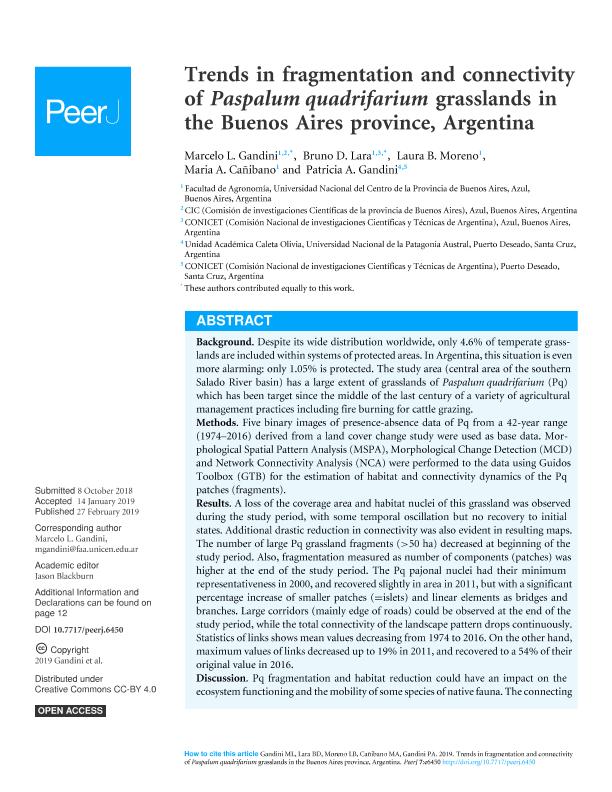Artículo
Trends in fragmentation and connectivity of Paspalum quadrifarium grasslands in the Buenos Aires province, Argentina
Gandini, Marcelo Luciano; Lara, Bruno Daniel ; Moreno, Laura Beatriz; Cañibano, María Alejandra; Gandini, Patricia Alejandra
; Moreno, Laura Beatriz; Cañibano, María Alejandra; Gandini, Patricia Alejandra
 ; Moreno, Laura Beatriz; Cañibano, María Alejandra; Gandini, Patricia Alejandra
; Moreno, Laura Beatriz; Cañibano, María Alejandra; Gandini, Patricia Alejandra
Fecha de publicación:
02/2019
Editorial:
PeerJ
Revista:
PeerJ
ISSN:
2167-8359
Idioma:
Inglés
Tipo de recurso:
Artículo publicado
Clasificación temática:
Resumen
Background. Despite its wide distribution worldwide, only 4.6% of temperate grasslands are included within systems of protected areas. In Argentina, this situation is even more alarming: only 1.05% is protected. The study area (central area of the southern Salado River basin) has a large extent of grasslands of Paspalum quadrifarium (Pq) which has been target since the middle of the last century of a variety of agricultural management practices including fire burning for cattle grazing. Methods. Five binary images of presence-absence data of Pq from a 42-year range (1974–2016) derived from a land cover change study were used as base data. Morphological Spatial Pattern Analysis (MSPA), Morphological Change Detection (MCD) and Network Connectivity Analysis (NCA) were performed to the data using Guidos Toolbox (GTB) for the estimation of habitat and connectivity dynamics of the Pq patches (fragments). Results. A loss of the coverage area and habitat nuclei of this grassland was observed during the study period, with some temporal oscillation but no recovery to initial states. Additional drastic reduction in connectivity was also evident in resulting maps. The number of large Pq grassland fragments (>50 ha) decreased at beginning of the study period. Also, fragmentation measured as number of components (patches) was higher at the end of the study period. The Pq pajonal nuclei had their minimum representativeness in 2000, and recovered slightly in area in 2011, but with a significant percentage increase of smaller patches (=islets) and linear elements as bridges and branches. Large corridors (mainly edge of roads) could be observed at the end of the study period, while the total connectivity of the landscape pattern drops continuously. Statistics of links shows mean values decreasing from 1974 to 2016. On the other hand, maximum values of links decreased up to 19% in 2011, and recovered to a 54% of their original value in 2016. Discussion. Pq fragmentation and habitat reduction could have an impact on the ecosystem functioning and the mobility of some species of native fauna. The connecting elements of the landscape were maintained and/or recovered in percentage in 2011 and 2016. This fact, although favoring the dispersion of the present diversity in the habitat nuclei could cause degradation by an edge effect. Part of the area has the potential to be taken as an area of research and as an example of livestock management, since it is the one that would most preserve the biodiversity of the Pq environment. On the methodological side, the use of a proved tool as GTB is useful for monitoring dynamics of a grassland-habitat fragmentation.
Archivos asociados
Licencia
Identificadores
Colecciones
Articulos(CCT - TANDIL)
Articulos de CTRO CIENTIFICO TECNOLOGICO CONICET - TANDIL
Articulos de CTRO CIENTIFICO TECNOLOGICO CONICET - TANDIL
Articulos(SEDE CENTRAL)
Articulos de SEDE CENTRAL
Articulos de SEDE CENTRAL
Citación
Gandini, Marcelo Luciano; Lara, Bruno Daniel; Moreno, Laura Beatriz; Cañibano, María Alejandra; Gandini, Patricia Alejandra; Trends in fragmentation and connectivity of Paspalum quadrifarium grasslands in the Buenos Aires province, Argentina; PeerJ; PeerJ; 2; 2-2019; 1-16
Compartir
Altmétricas



